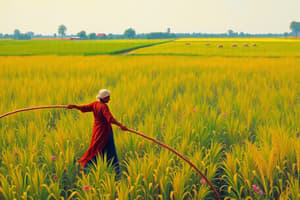Podcast
Questions and Answers
What is the main characteristic of primitive subsistence farming?
What is the main characteristic of primitive subsistence farming?
- It relies heavily on modern fertilizers and pesticides.
- It aims for high productivity using intensive farming methods.
- It involves small plots of land and simple tools. (correct)
- It uses advanced machinery for crop production.
Which of the following is NOT a method used in primitive subsistence farming?
Which of the following is NOT a method used in primitive subsistence farming?
- Use of advanced irrigation systems. (correct)
- Planting crops to meet family needs.
- Slash and burn clearing of land.
- Relocation to new land when soil fertility declines.
What affects the productivity of primitive subsistence farming?
What affects the productivity of primitive subsistence farming?
- Heavy use of fertilizers and herbicides.
- Employment of cutting-edge agricultural technology.
- High demand for agricultural exports.
- Dependence on monsoon rains and soil fertility. (correct)
Which of the following terms is used for primitive subsistence farming in the North-eastern states of India?
Which of the following terms is used for primitive subsistence farming in the North-eastern states of India?
Why do farmers practicing primitive subsistence farming move to a new patch of land?
Why do farmers practicing primitive subsistence farming move to a new patch of land?
What is the main reliance of primitive subsistence farming in India?
What is the main reliance of primitive subsistence farming in India?
Primitive subsistence farming utilizes advanced tools and high levels of input.
Primitive subsistence farming utilizes advanced tools and high levels of input.
Name one of the regions in India where primitive subsistence farming is practiced.
Name one of the regions in India where primitive subsistence farming is practiced.
Farmers practicing this type of farming often clear land by __________ and burning vegetation.
Farmers practicing this type of farming often clear land by __________ and burning vegetation.
Match the following names of primitive subsistence farming with their respective regions:
Match the following names of primitive subsistence farming with their respective regions:
Flashcards are hidden until you start studying
Study Notes
Importance of Agriculture in India
- Two-thirds of India's population is involved in agriculture.
- Agriculture provides food grains and raw materials for industries.
- Some agricultural products are exported, including tea, coffee, and spices.
Types of Farming in India
- Agriculture in India has evolved and transitioned over time.
- Farming in India is influenced by environmental factors, technology, and social customs.
Primitive Subsistence Farming
- Still practiced in some areas of India.
- Small plots of land are farmed.
- Simple tools are used, such as hoes.
- Family or community labor is the primary source of labor.
- Highly reliant on the monsoon season and natural soil fertility.
- Method: Slash-and-burn technique is employed to clear land for crops.
Variations of Primitive Subsistence Farming
- Jhumming (North-eastern states: Assam, Meghalaya, Mizoram, and Nagaland)
- Pamlou (Manipur)
- Dipa (Bastar district of Chhattisgarh)
- Other names in various regions.
Low Productivity of Primitive Subsistence Farming
- Primitive farming is less productive due to low land yield.
- This lack of productivity stems from the absence of fertilizers or modern input methods.
Farming in India
- India has a large agricultural sector that employs two-thirds of its population.
- Agriculture in India is the source of food grains and raw materials for various industries.
- Some agricultural products, like tea, coffee, and spices, are exported from India.
- Modernization has led to changes in farming practices, influenced by environmental factors, technology, and socio-cultural practices.
- Primitive subsistence farming persists in certain regions of India.
Primitive Subsistence Farming
- This type of farming is characterized by small landholdings, simple tools like hoes, and reliance on family or community labor.
- Farming techniques heavily depend on the monsoon season and natural soil fertility.
- Farmers use a "slash and burn" method to clear land for cultivation, planting crops to sustain their families.
- When soil fertility declines, they move to a new patch of land, allowing the previous one to recover.
- This practice has different names in various regions, including:
- Jhumming in North-eastern states like Assam, Meghalaya, Mizoram, and Nagaland.
- Pamlou in Manipur.
- Dipa in the Bastar district of Chhattisgarh.
- Other names in diverse regions.
- Primitive subsistence farming has low land productivity due to the lack of fertilizers and modern inputs.
Studying That Suits You
Use AI to generate personalized quizzes and flashcards to suit your learning preferences.




